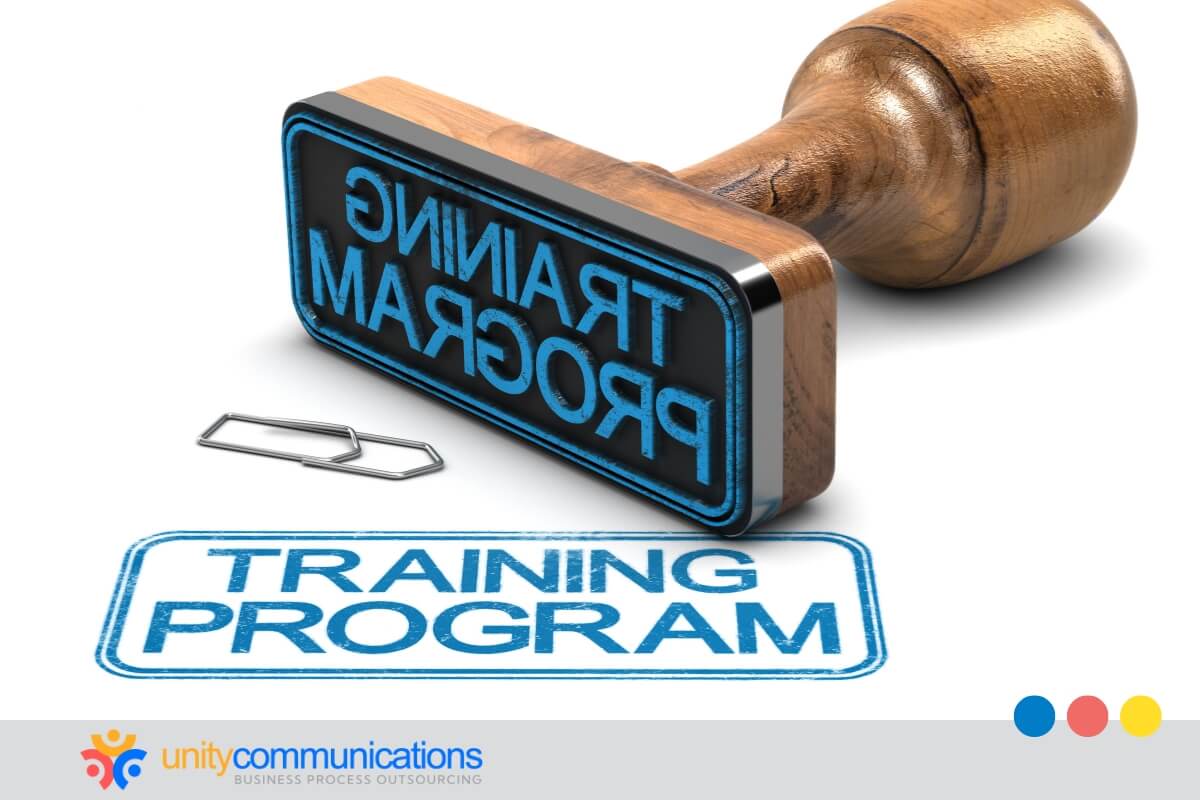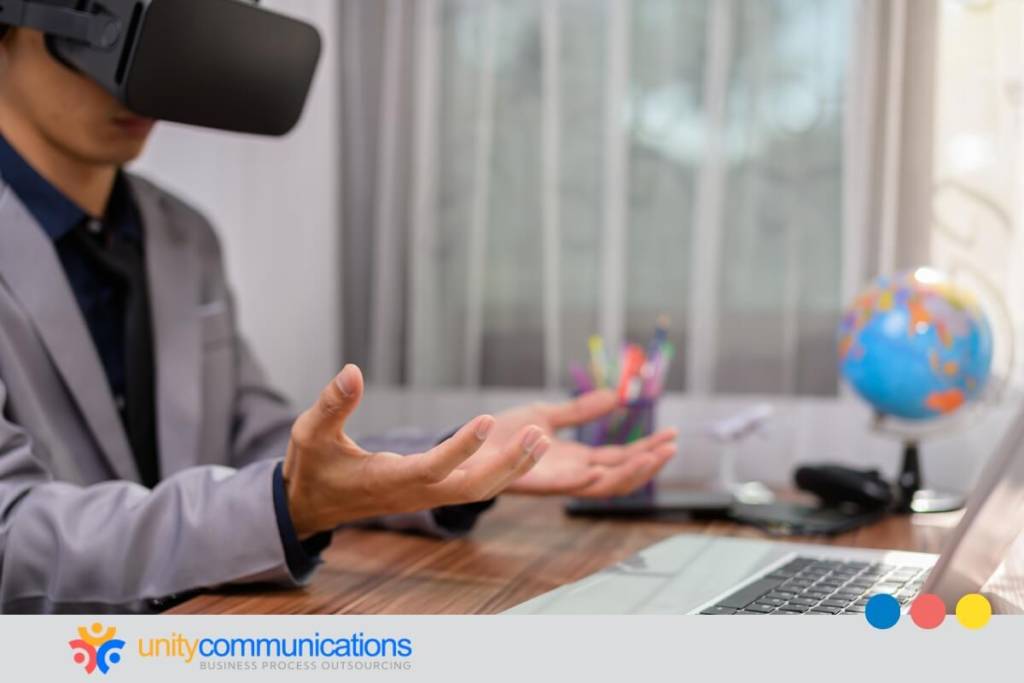Table of Contents
A lack of workforce engagement and interactivity increases employee burnout, especially when handling demanding tasks and tight deadlines. This gap is prevalent in fast-paced environments, such as the business process outsourcing (BPO) sector.
Monotonous training and heavy workloads result in decreased productivity and poor performance. Unmet training goals and low-quality deliverables impede operations. Hence, service providers explore innovative ways to overcome these challenges and mitigate their impacts.
One practical measure is incorporating augmented reality in BPO training and operations. Keep reading to learn how support vendors leverage this advanced technology.
Ways augmented reality revolutionizes BPO training

Workforce training is a driving force behind company growth. According to Deloitte’s 2024 Global Human Capital Trends report, enterprises prioritizing skills development have better business results. Deloitte also found that 84% of employees from high-performing organizations receive the needed training to accomplish tasks well.
However, traditional training methods no longer encourage and engage today’s workforce. Text-heavy manuals and regular lectures are primarily passive. Employees struggle to focus or recognize their value because the methods do not cater to individual learning styles.
That is what BPO companies address by adopting augmented reality (AR). Below are practices they implement to advance workforce training and skills enhancement.
Enable interactive simulations
AR enables interactive simulations, allowing employees to address problems through realistic role-playing scenarios. For instance, new customer service representatives (CSRs) wear AR glasses to experience facing frustrated consumers in a virtual environment.
The device generates holographic avatars that act as buyers complaining about their damaged purchases. It produces text- or voice-based prompts to guide agents in executing proper de-escalation techniques and effective communication strategies.
In product manufacturing and testing, providers use the emerging tool to overlay 3D models of complex processes onto the workspace. It allows workers to practice step-by-step production procedures in a risk-free environment, minimizing errors and optimizing resources.
Bridge the gap between theory and practice
Some traditional BPO training methods introduce a gap between learning theories and practical applications. Full-text manuals and courses might discourage employees from training, especially when they prefer to read shorter paragraphs.
Augmented reality helps BPO companies address such training issues by superimposing digital operations data directly onto the work environment. This tool allows employees to see real-time prompts and annotations on software interfaces they use on the job.
For example, an AR program highlights specific buttons on new software and visually guides employees through a complex troubleshooting process using short text commands. The solution can also provide immediate feedback on employee performance.
Workers can see suggestions overlaid on their courses during simulations. AR immediately flashes corrections upon identifying mistakes. This continuous feedback loop helps individuals learn from their errors and improve attentiveness and accuracy.
Personalize and scale learning paths
Providers tailor AR training content to individual learning styles and skill levels. They might incorporate gamification and reward elements that match employees’ preferences. These features help workers focus on specific areas of improvement and adjust their learning pace.
Moreover, BPO employers regularly update their AR training platforms and distribute them across geographically dispersed teams. Remote workers can thus access training modules on-demand using AR headsets or mobile devices, allowing them to learn at their convenience.
The impact of augmented reality on BPO operations

Aside from training purposes, BPO vendors optimize AR to boost efficiency and service delivery. The technology’s impact spans across several outsourcing domains, making a significant difference in these critical areas:
- Technical support. AR assists CSRs by overlaying information and guidelines directly onto their screens. They can help customers through troubleshooting steps virtually, reducing the need for follow-up calls or technician visits for basic computer issues.
- Process optimization. AR visualizes potential bottlenecks in workflows and recommends ways to address them in real time. Instantaneous data and visual cues help lessen human errors in data entry, process execution, and quality assurance.
- Sales and marketing. AR establishes brand awareness, consideration, conversion, and loyalty across the customer journey. Hence, sales and marketing BPO agencies use AR to offer interactive product demonstrations to improve client engagement and retention.
Deploying augmented reality in BPO training and operations

BPO companies must create and implement robust measures to successfully use AR for training and operations. Careful planning, thorough implementation, and ongoing evaluation help them maximize the benefits of AR technology. These best practices assist them in achieving such goals:
- Specify areas for AR integration. Providers identify training modules and functions where visual and interactive elements can simplify understanding and completion. These areas include software troubleshooting and virtual product demonstration.
- Set measurable objectives for AR deployment. Service vendors outline their targets for deploying augmented reality in BPO training and operations. They create metrics to assess the effectiveness of AR initiatives on employee performance and productivity.
- Select the best AR technology. BPO companies acquire user-friendly AR devices that fit their operational needs and budgets. For instance, they choose AR-based tablets for interactive product presentations and smart glasses for manufacturing training.
- Perform AR pilot testing. Vendors initially try out their AR platforms in a controlled environment. This action helps them collect feedback from beta users to pinpoint compatibility and functionality issues and mitigate them before full-scale deployment.
- Execute robust data and privacy protection measures. Providers ensure the AR platform meets information security standards during pilot testing. They also implement multifactor authentication and encryption to safeguard sensitive user data.
- Develop and implement comprehensive training programs. BPO firms create immersive and interactive AR training modules. They base the content on specific processes and user preferences.
The bottom line
The fast-paced and demanding nature of the BPO industry puts workers in a state of burnout. However, transforming traditional training methods and optimizing daily operations with AR helps service providers enhance efficiency, accuracy, and employee empowerment.
While AR adoption in outsourcing is still in its early stages, BPO companies have already experienced practical benefits. For instance, enabling interactive simulations via AR platforms streamlines learning, skill development, and service delivery.
Do you want to learn more about how a BPO company utilizes AR? Let’s connect today and exchange insights!




